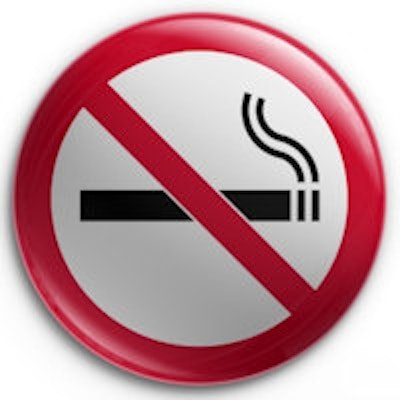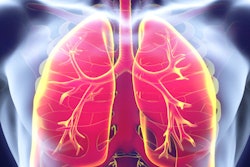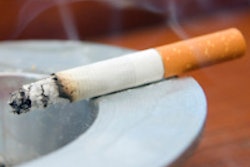
Long-term smokers who are at high risk for lung cancer but don't qualify for CT screening under the strict guidelines of the National Lung Screening Trial (NLST) nevertheless have the same rate of cancers as those who do qualify, concludes a study in the February Journal of the American College of Radiology.
Massachusetts researchers screened more than 1,700 patients for lung cancer, including approximately 1,200 who qualified under NLST guidelines and nearly 500 high-risk individuals who didn't qualify. For example, a nonqualified participant may have had 20 rather than 30 pack-years of smoking history, or may have quit smoking 20 rather than 15 years earlier, if at all (JACR, February 2016, Vol. 13:2, Supplement, pp. R8-R13).
Yet despite differences in age, smoking history, and length of time since quitting, "the performance of lung screening between the two groups was the same," said lead author Dr. Brady McKee in an interview with AuntMinnie.com. "So the positive rates were about the same, the incidental finding rates were about the same ... and the cancer detection rate was basically the same between both groups, and it was similar to what we expected we would see for that population based on prior reports,"
Other screening criteria
An estimated 7 million individuals in the U.S. qualify for CT lung cancer screening under guidelines approved last year by the U.S. Centers for Medicare and Medicaid Services (CMS). The screening guidelines are largely based on qualifying criteria for the National Lung Screening Trial (NLST), which in 2011 found a 20% mortality benefit among long-term smokers who were screened with CT.
 Dr. Brady McKee from Lahey Hospital and Medical Center.
Dr. Brady McKee from Lahey Hospital and Medical Center.To be eligible for screening under those guidelines and receive Medicare reimbursement, an individual must have at least 30 pack-years of smoking history and be 55 to 74 years old. However, there are other risk factors for lung cancer that NLST wasn't designed to address.
"NLST was designed to measure those primary risk factors; it was not supposed to be a comprehensive risk-based assessment of everyone who could benefit from lung screening," said McKee, who is head of thoracic imaging at Lahey Hospital and Medical Center in Burlington, MA.
Several medical societies have issued screening guidelines: In particular, the National Comprehensive Cancer Network (NCCN) and others have created a more comprehensive picture of risk factors to include younger patients, older patients, and others considered to be at high risk for lung cancer.
NCCN created two categories of high-risk screening subjects, NCCN1 and NCCN2. NCCN1 subjects mirror the NLST criteria: individuals 55 to 74 years of age who have a minimum 30-pack-year smoking history or who have quit within the past 15 years.
The NCCN2 high-risk group consists of current or former smokers with 20 or more pack-years of history. NCCN2 also requires at least one additional risk factor for lung cancer, be it the presence of chronic lung disease, such as emphysema or pulmonary fibrosis, or a family history of lung cancer in a first-degree relative.
Screening before NLST
Including the NCCN2 population in lung cancer screening has been controversial because this group was not evaluated formally in NLST or other screening trials, the authors wrote. But there were no NLST guidelines when the research began in 2012, and the institution later began offering CT lung cancer screening as a community benefit to individuals qualifying for either the NCCN1 or NCCN2 groups.
The study compared demographic characteristics and rates of positive findings, significant incidental findings, and malignancy between the NCCN1 and NCCN2 groups, as well as with the NLST results.
The researchers included exams performed between 2012 and 2014. Studies were read by radiologists credentialed in structured CT lung screening reporting. Positive results required a solid nodule 4 mm or larger, a ground glass nodule 5 mm or larger, or a mediastinal or hilar lymph node larger than 1 cm, not stable for more than two years. The group also reported significant incidental findings.
Similarities between groups
The screening cohort included 464 subjects in NCCN2 and 1,296 subjects in NCCN1, for a total of 1,760 exams.
In all, 481 (27.3%) of the 1,760 CT scans had a positive finding, including 25% of NCCN2 patients and 28.2% of NCCN1 patients. In addition, 108 (6.1%) of the 1,760 exams had a significant incidental finding, and 114 (6.5%) of the 1,760 exams had findings that were suspicious for pulmonary infection or inflammation, including 6% of group 2 and 6.6% of group 1.
Clinical follow-up was available for 331 patients in NCCN2 and 997 patients in NCCN1. Twenty-three (1.6%) of the 1,328 patients were diagnosed with at least one lung cancer, including six (1.8%) of the 331 patients in NCCN2 and 17 (1.7%) of 997 in NCCN1. The overall annualized rate of malignancy was 1.8% in NCCN2 and 1.6% in NCCN1.
The lung cancer cases included 11 patients (48%) with adenocarcinoma, five (22%) with squamous cell carcinoma, two (9%) with small cell carcinomas, one (4%) with a carcinoid, and one (4%) with three synchronous small primary lung cancers, squamous cell carcinoma, adenocarcinoma, and adenosquamous carcinoma.
The main difference between the NCCN1 and NCCN2 groups was the length of time since smoking cessation at screening: 18.5 years in group 2 versus 6.7 years in group 1. Most of the cancers reported for the study were detected at baseline.
"You need long-term follow-up to find the incidence cancers," McKee said.
| Comparison of malignancy rate by group | |||||
| NCCN2 | NCCN1 | ||||
| Overall malignancy rate | 6/331 (1.8%) | 17/997 (1.7%) | |||
| Average follow-up (months) | 12.1 | 12.7 | |||
| Months to diagnosis | 5.6 | 3.7 | |||
| Average follow-up from diagnosis (months) | 5.3 | 8.6 | |||
The rate of clinically significant incidental findings was also nearly identical for the NCCN2 and NCCN1 groups, at about 6%, significantly lower than the 10.2% reported in NLST. The lower rate might be explained by the fact that about one-fifth of screening subjects had prior cross-sectional imaging before presenting for screening, the authors wrote.
Expanding screening eligibility to include the NCCN2 group could increase the number of qualified Americans by about 2 million. This includes 600,000 people who would meet the NLST entry criteria except that they quit smoking more than 15 years ago, according to McKee and colleagues.
"Providing NCCN group 2 with access to CT lung screening offers the potential to save thousands of additional lives each year," McKee said.
CMS and the U.S. Preventive Services Task Force (USPSTF) have already gotten the ball rolling by extending the upper age for screening to 77 and 80 years, respectively, he said.
Among the societies that have developed screening guidelines, the American Association for Thoracic Surgery's (AATS) approach is interesting because it bases eligibility for screening entirely on risk, taking demographics out of the equation, McKee noted.
Per AATS, "if you have a 5% risk of developing lung cancer within the next five years, then you can be screened," he said. This approach offers an avenue for people who don't meet traditional risk factors but are likely to be at much higher risk.
Screening high-risk individuals ineligible under NLST criteria "gives you the power to save thousands of additional lives per year, which is a good thing if it's not introducing unknown additional harms to that patient population," McKee said.




















